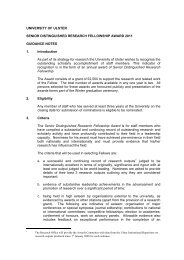biomedical sciences research institute - Research - University of Ulster
biomedical sciences research institute - Research - University of Ulster
biomedical sciences research institute - Research - University of Ulster
- No tags were found...
Create successful ePaper yourself
Turn your PDF publications into a flip-book with our unique Google optimized e-Paper software.
4. BIOMEDICAL GENOMICS RESEARCH GROUPOVERVIEW BY THE GROUP LEADERThe Mission <strong>of</strong> the Biomedical Genomics <strong>Research</strong> Group is to conduct <strong>research</strong> that will lead to a greaterunderstanding <strong>of</strong> the function <strong>of</strong> genes and regions for which there is no known function (Functional Genomics);the molecular understanding <strong>of</strong> gene regulation and gene expression patterns; and, ultimately, the development <strong>of</strong>novel techniques to therapeutically alter the expression <strong>of</strong> affected genes.The Group has extensive expertise relating to transcriptional regulation, key proteomic- and nucleic acid- basedtechniques (SNP, methylation, microarray, gene knockout, QTOF MS based de novo protein sequencing, MALDI,Yeast-2-hybrid, 2-D PAGE); structural biology (solution NMR spectroscopy); data integration and pathway modelling(Systems Biology). Genomics, proteomics and Systems Biology are strongly inter-related and many complexbiological and <strong>biomedical</strong> questions demand an integration <strong>of</strong> these approaches.Therefore, the Group works in contact with most <strong>of</strong> the <strong>research</strong> groups within the Biomedical Sciences <strong>Research</strong>Institute (BMSRI), and particularly with the Systems Biology <strong>Research</strong> Group.The group is involved in all major aspects <strong>of</strong> transcriptional regulation ranging from:• the investigation <strong>of</strong> basic mechanisms <strong>of</strong> gene regulation;• the investigation <strong>of</strong> the structural basis for mechanisms <strong>of</strong> transcriptional control and regulation;• the design <strong>of</strong> nucleic acid based composites to therapeutically modulate aberrant gene expression patterns;• the analysis <strong>of</strong> the interplay <strong>of</strong> disease and a major class <strong>of</strong> transcriptional regulators (the “superfamily” <strong>of</strong>nuclear hormone receptors with a specific focus on the vitamin D receptor);• the analysis <strong>of</strong> the correlation between genetic variability (SNPs), gene expression, promoter methylationstatus and specific diseases.14
















